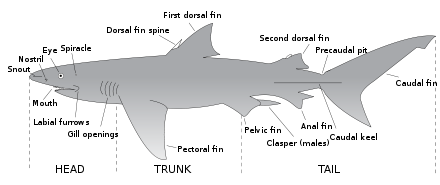- Fish locomotion
-
The prevailing type of fish locomotion is swimming in water. In addition, some fish can "walk", i.e., move over land, burrow in mud, and glide through the air.
Contents
Swimming
Fish swim by exerting force against the surrounding water. There are exceptions, but this is normally achieved by the fish contracting muscles on either side of its body in order to generate waves of flexion that travel the length of the body from nose to tail, generally getting larger as they go along. The vector forces exerted on the water by such motion cancel out laterally, but generate a net force backwards which in turn pushes the fish forward through the water.
Most fishes generate thrust using lateral movements of their body & caudal fin. But there are also a huge number of species that move mainly using their median and paired fins. The latter group profits from the gained manoeuvrability that is needed when living in coral reefs for example. But they can't swim as fast as fish using their bodies & caudal fins.
Body/caudal fin propulsion
There are four groups that differ in the fraction of their body that is displaced laterally [1]:
Anguilliform locomotion
In some long, slender fish – eels, for example – there is little increase in the amplitude of the flexion wave as it passes along the body.
Sub-carangiform locomotion
Here, there is a more marked increase in wave amplitude along the body with the vast majority of the work being done by the rear half of the fish. In general, the fish body is stiffer, making for higher speed but reduced maneuverability. Trout use sub-carangiform locomotion.
Carangiform locomotion
Fish in this group are stiffer and faster-moving than the previous groups. The vast majority of movement is concentrated in the very rear of the body and tail. Carangiform swimmers generally have rapidly oscillating tails.
Thunniform locomotion
The final group is reserved for the high-speed long-distance swimmers, like tuna (new research shows that the thunniform locomotion is an autapomorphy of the tunas [2]). Here, virtually all the lateral movement is in the tail and the region connecting the main body to the tail (the peduncle). The tail itself tends to be large and crescent shaped.
Median/paired fin propulsion
Not all fish fit comfortably in the above groups. Ocean sunfish, for example, have a completely different system, and many small fish use their pectoral fins for swimming as well as for steering and dynamic lift. Fish with electric organs, such as those in Gymnotiformes, swim by undulating their fins while keeping the body still, presumably so as not to disturb the electric field that they generate.
Dynamic lift
Bone and muscle tissues of fish are denser than water. To maintain depth some fish increase buoyancy by means of a gas bladder or by storing oils or lipids. Fish without these features use dynamic lift instead. It is done using their pectoral fins in a manner similar to the use of wings by aeroplanes and birds. As these fish swim, their pectoral fins are positioned to create lift which allows the fish to maintain a certain depth.
Sharks are a notable example of fish that depend on dynamic lift; notice their well-developed pectoral fins.
The two major drawbacks of this method are that these fish must stay moving to stay afloat and that they are incapable of swimming backwards or hovering.
Walking
Main article: Walking fishBurrowing
Many fishes, particularly eel-shaped fishes such as true eels, moray eels, and spiny eels, are capable of burrowing through sand or mud.[1] Ophichthids are capable of digging backwards using a sharpened tail.
Flying
See also: flying fish and flying and gliding animalsReferences
- [1] C.M. Breder, “The locomotion of fishes”, Zoologica, vol. 4, pp. 159-297, (1926) The Journal of Experimental Biology 206, 2749-2758 (2003)
- [2] Hawkins J. Dowis, Chugey A. Sepulveda, Jeffrey B. Graham and Kathryn A. Dickson, "Swimming performance studies on the eastern Pacific bonito Sarda chiliensis, a close relative of the tunas (family Scombridae) II. Kinematics", The Journal of Experimental Biology 206, 2749-2758 (2003)
See also
- Aquatic locomotion
- Undulatory locomotion
- Tradeoffs for Locomotion in Air and Water
External links
Categories:
Wikimedia Foundation. 2010.


